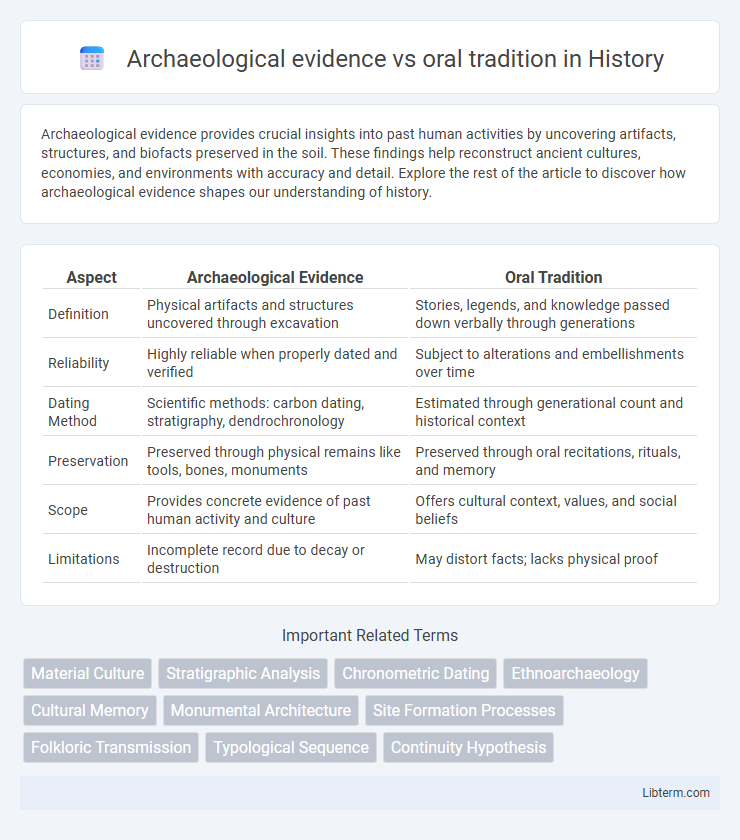Archaeological evidence provides crucial insights into past human activities by uncovering artifacts, structures, and biofacts preserved in the soil. These findings help reconstruct ancient cultures, economies, and environments with accuracy and detail. Explore the rest of the article to discover how archaeological evidence shapes our understanding of history.
Table of Comparison
| Aspect | Archaeological Evidence | Oral Tradition |
|---|---|---|
| Definition | Physical artifacts and structures uncovered through excavation | Stories, legends, and knowledge passed down verbally through generations |
| Reliability | Highly reliable when properly dated and verified | Subject to alterations and embellishments over time |
| Dating Method | Scientific methods: carbon dating, stratigraphy, dendrochronology | Estimated through generational count and historical context |
| Preservation | Preserved through physical remains like tools, bones, monuments | Preserved through oral recitations, rituals, and memory |
| Scope | Provides concrete evidence of past human activity and culture | Offers cultural context, values, and social beliefs |
| Limitations | Incomplete record due to decay or destruction | May distort facts; lacks physical proof |
Introduction to Archaeological Evidence and Oral Tradition
Archaeological evidence consists of physical artifacts, structures, and biofacts that provide verifiable data about past human activities, serving as tangible proof in historical research. Oral tradition encompasses the transmission of cultural knowledge, stories, and customs through spoken word across generations, often preserving collective memory without written records. Examining both archaeological evidence and oral tradition allows for a comprehensive understanding of history by integrating material findings with intangible cultural narratives.
Defining Archaeological Evidence
Archaeological evidence comprises physical artifacts, structures, and biofacts uncovered through systematic excavation and scientific analysis, providing tangible data about past human activities and cultures. This evidence is characterized by its materiality and empirical nature, allowing researchers to reconstruct historical contexts and verify chronological sequences with methods such as radiocarbon dating and stratigraphy. Unlike oral tradition, archaeological evidence offers direct, measurable proof that supports or challenges historical narratives derived from inherited stories and cultural memory.
Understanding Oral Tradition
Oral tradition preserves historical narratives through generations, offering cultural context and indigenous perspectives often missing in archaeological records. While archaeological evidence provides physical artifacts and stratigraphic data that validate timelines, oral tradition enriches interpretations by conveying social values, myths, and ancestral knowledge. Integrating oral accounts with archaeological findings enables a comprehensive understanding of past societies beyond material remains.
Historical Reliability: Strengths and Limitations
Archaeological evidence provides tangible, datable artifacts and structures that establish a concrete historical framework with measurable authenticity. Oral tradition offers rich cultural insights and preserves historical narratives, especially in societies lacking written records, but its reliability can be affected by distortion over generations and subjective interpretation. Combining both methods enhances historical accuracy by balancing the physical verification of archaeology with the contextual depth of oral accounts.
Case Studies: When Archaeology Confirms Oral Accounts
Archaeological evidence often validates oral traditions by uncovering physical artifacts that correspond to narrated historical events, such as the discovery of the ancient city of Troy corroborating Homer's epic accounts. Excavations at sites like Cahokia in North America have confirmed indigenous oral histories about complex pre-Columbian societies, bridging the gap between folklore and material culture. These case studies highlight the synergy between tangible archaeological data and intangible oral narratives, enhancing our understanding of past civilizations.
Conflicting Narratives: Archaeology vs Oral Tradition
Conflicting narratives between archaeological evidence and oral tradition often arise due to discrepancies in timelines, interpretative frameworks, and cultural perspectives. Archaeology relies on material artifacts, stratigraphy, and carbon dating to construct historical timelines, while oral traditions preserve community memory through stories, myths, and rituals that may adapt over generations. Resolving these conflicts requires interdisciplinary approaches that respect the empirical rigor of archaeology alongside the cultural significance and context embedded in oral histories.
Methodologies for Integrating Both Approaches
Integrating archaeological evidence with oral tradition requires a multidisciplinary methodology combining field excavation data, stratigraphic analysis, and radiocarbon dating alongside ethnographic interviews and linguistic analyses. Employing Geographic Information Systems (GIS) can spatially correlate oral narratives about historical sites with archaeological findings. Collaborative frameworks involving indigenous knowledge holders and archaeologists ensure culturally-sensitive interpretations, enriching historical reconstructions and validating oral histories through tangible material evidence.
Cultural Significance of Oral Tradition in Historical Reconstruction
Oral tradition holds immense cultural significance in historical reconstruction, preserving indigenous knowledge and societal values passed down through generations, often filling gaps left by limited archaeological evidence. It provides nuanced narratives and contextual understanding of historical events that artifacts alone cannot convey, thus enriching the interpretation of past cultures. By complementing archaeological data, oral traditions enable a more comprehensive and culturally respectful reconstruction of histories, particularly for societies with limited written records.
Modern Advances in Archaeological Interpretation
Modern advances in archaeological interpretation leverage technologies such as LiDAR scanning, radiocarbon dating, and DNA analysis to provide tangible evidence that complements and verifies oral traditions. These methods enable researchers to uncover previously hidden structures, artifacts, and genetic lineages, bridging gaps between historical narratives and physical records. Integration of digital modeling and interdisciplinary approaches has significantly enhanced the accuracy of reconstructing ancient societies and validating cultural memory preserved through oral accounts.
Future Perspectives: Bridging the Gap Between Evidence and Tradition
Future perspectives in bridging archaeological evidence and oral tradition emphasize integrative methodologies that combine advanced technologies, such as remote sensing and DNA analysis, with ethnographic studies, ensuring a holistic understanding of historical narratives. Collaborative frameworks between archaeologists and indigenous communities enhance the validation and contextualization of oral histories, enriching archaeological interpretations with cultural significance. Emerging interdisciplinary approaches promise to refine historical timelines and foster inclusive heritage preservation strategies that honor both empirical data and ancestral knowledge.
Archaeological evidence Infographic

 libterm.com
libterm.com